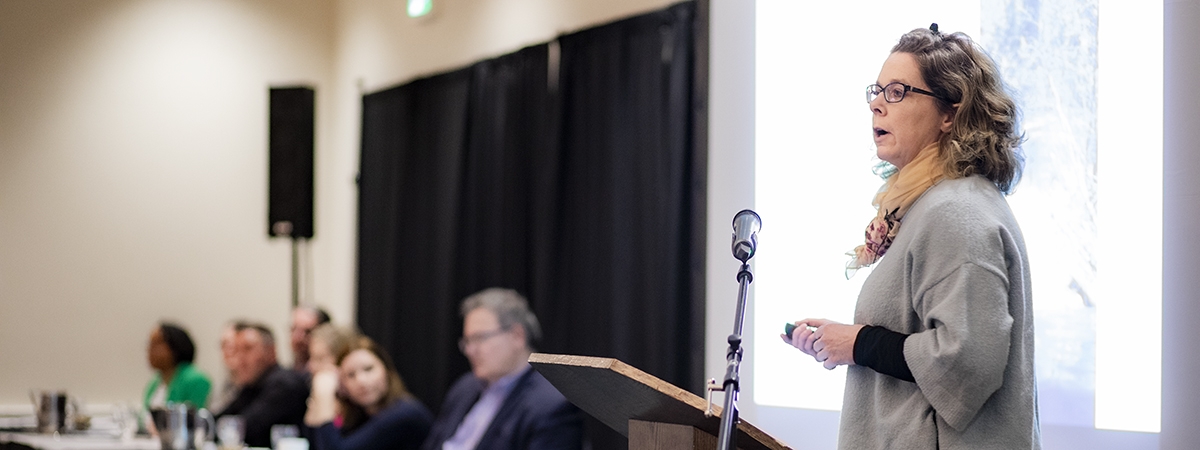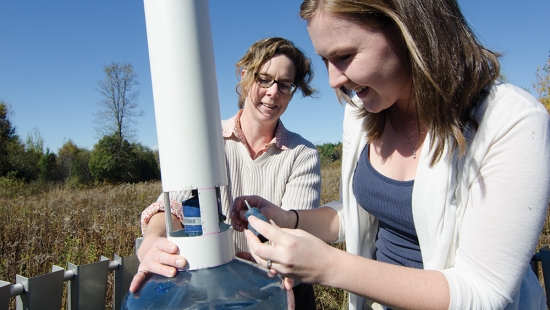Dr. James reflects on decade as Canada Research Chair

Dr. April James recently completed a ten-year term as Canada Research Chair in Watershed Analysis and Modeling at Nipissing University. The NU News sat down with Dr. James to reflect on her contributions over the past decade.
When did your initial term begin?

I arrived in North Bay in July 2010, that’s when I started at Nipissing University. Before that, I was an assistant professor at North Carolina State University in Raleigh, NC. I had been in the U.S. on and off for about 15 years and worked as a professional scientist. I did a graduate degree in South Carolina after finishing my degree here in Canada and then I worked at the Lawrence Berkeley National Laboratory in California doing research full-time. I returned to Canada to get a PhD at McGill University in Montreal and then I went back to the States for a post-doctoral research position. I got my first job as an Assistant Professor in the Department of Forestry and Environmental Resources at North Carolina State University.
I held the Tier II Canada Research Chair in Watershed Analysis and Modeling for a total of 10 years. In the fifth year in 2014, I was able to reapply with support from the University. At the end of the fourth year in 2014, the University supported my proposal to renew and I was able reapply to the federal government for this funding and I was awarded another five-year term.
What type of research did you conduct during your time as a Canada Research Chair?
By training, I’m a hydrologist so my research group examines physical hydrological processes that control how water moves through our watersheds from the landscape into wetlands, streams, rivers or lakes. We’re all about how water moves, the flow paths it takes and how long it takes to arrive into the aquatic environment. This kind of basic information also supports studies of water quality. Water quality is affected by the pathway water takes, what it picks up along the way and how long it sits in different parts of the landscape (both surface and subsurface). It’s also very relevant to human impact on landscapes.
What was a highlight for you during your experience as a Canada Research Chair?
The Canada Research Chair (CRC) program is a national strategy to make Canada one of the world’s top countries in research and development. It invests a lot of money to attract and retain researchers in Canada. For example it attracted me back from the U.S.. As a CRC candidate, when we apply for this funding, we are applying with the university to win funding from the federal government. So those funding packages that get put together, when approved, support some amazing opportunities that might not otherwise be offered elsewhere.
One of the things we did with the funding was purchase equipment for our laboratory that allowed us to analyze water for ratios of oxygen and hydrogen, different isotopes (or different versions) of oxygen and hydrogen in the water molecule. This allows us to better understand water movement. Another thing we were able to do with the funding was conduct high frequency monitoring of weather and water conditions on Lake Nipissing. We’ve been doing that for five or six years now and it helps to investigate in-lake processes - not only what happens on the landscape, but what happens within our lakes.

The Canada Research Chair Program also allowed us to purchase a new 24-foot research vessel, essentially a 24-foot boat that allows us to safely go out on Lake Nipissing during the ice-off season, a fairly large body of water, and deploy floating buoys that include a suite of instruments that collected all of these high-frequency or continuous measurements of what’s happening in the water column from temperature, to dissolved oxygen, to other water quality measures.
What influenced you to become a Canada Research Chair?
I saw the advertisement for the Canada Research Chair Program that was put out by Nipissing University a couple years ahead of when I arrived and I applied because I grew up in Sudbury. It was a very attractive chance to come back to Canada and work in my field as a professor and to do research in Northeastern and Central Ontario, and that to me was really quite exciting.
How does the Canadian Research Chair Program benefit Nipissing University and the community?
A lot of the research projects that we’ve been developing aim to partner with local organizations including the North Bay-Mattawa Conservation Authority, the provincial Ministry of Environment, Conservation and Parks, as well as other researchers at Nipissing and other universities. We were particularly focused over the last five to six years on studying how phosphorous and weather conditions can be contributing factors to the occurrence of harmful algae blooms in local lakes. Some of the work that we are doing focuses on Callander Bay which is the drinking water source for the municipality of Callander.
The CRC award, in partnership with matching funding from Nipissing University, has allowed us to support graduate students in the Masters of Environmental Studies/Masters in Environmental Sciences joint graduate program. It gives us a chance to do research together, to get students involved, to get them doing research in the field, and working on some of these interesting data-sets, and to give them new opportunities to do research here in northeastern Ontario. All of that was really facilitated by the Canada Research Chair Program and chair that I have held over the last ten years.
For more information and updates on the Integrative Watershed Research Centre led by Dr. James, visit iwrc.nipissingu.ca or faculty.nipissingu.ca/aprilj.
